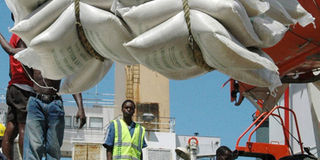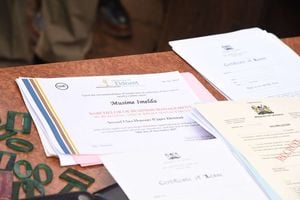Sugar, maize imports to test Uhuru’s EAC integration plan

Imported sugar is offloaded at the port of Mombasa. Photo/FILE
What you need to know:
- Goods from the bloc have seen the prices of local produce plummet much to the displeasure of farmers who are calling on the government to intervene
Just weeks after gaining full access to export sugar to Kenya, Uganda is preparing to cause another upset. This time, it is eyeing Kenya’s troubled maize market.
And while the debate on sugar has been soured by talk of Kampala being used to dump the commodity in Kenya, now the talk surrounding the grain business is on pricing.
At the moment, maize from Uganda is retailing at Sh800 per 90kg bag. Tanzania is also producing maize at relatively cheaper price than Kenya and is fast making headway in boosting its revenue by taking a pie of the local market.
The cheaper imports have seen the price of maize in Kenya drop significantly triggering political discontent in some of the ruling coalition’s strongholds.
This is likely to test President Uhuru Kenyatta’s leadership in East Africa Community especially on integration which guarantees free movement of goods and labour.
The need to calm the political jitters forced Agriculture Cabinet secretary Felix Koskei to announce a change in the price of maize mid-December last year.
The government had announced it would buy a 90-kg bag of maize at Sh2,200 only for the minister to increase it to Sh2,300 in less than 24 hours.
Free trade area
Mr Koskei was reacting to piling pressure from farmers in North Rift who were opposed to the set price saying they wanted to sell the 90kg bag for Sh3,500.
Addressing the media at Kilimo House, Mr Koskei said the price was set in line with the prevailing market prices that range between Sh1,300 and Sh2,300.
He said the Kenyan price is consistent with the free trade area created within the EAC.
“The price considered that we are in a free trade area with other East African Community states,” Mr Koskei said.
Experts say Uganda and Tanzania farmers enjoy distinct advantages over their Kenyan counterparts that make their production costs lower. These include richer soils and favourable land tenure system.
“The production regime structure in Uganda is lower as there is no much pressure to produce maize because it’s not their staple food. They also have diversified food sources. In Tanzania, they have expansive farmland therefore they enjoy economies of scale (buying in bulk hence lower cost per unit),” said Saulo Busolo, interim director-general of Agriculture, Food and Fisheries Authority .
“Here (Kenya) there is land pressure and over-reliance on maize. What we are doing is subsidising to cut on production cost.”
Mr Koskei said a study established that it cost Kenyan farmers between Sh1,500 and Sh1,800 to produce a 90-kilo bag of maize depending on ecological zone.
On Sugar, Kenya was last year forced to give in to imports after traders in Uganda demanded access to the local market.
The Ugandans had complained that Kenya was putting roadblocks against them at the border contrary to the free trade agreements. President Yoweri Museveni successfully jumped to their defence.
Sugar safeguards
Kenya has a cap on sugar imports at 300,000 tonnes to protect local millers from competition. The country produces about 600,000 tonnes a year.
As sugar safeguards come to an end next month, opening floodgates for sugar from Common Market for Eastern and Southern countries, Kenya is expected to come under pressure to save its sugar factories from collapse as its more expensive product competes for space in the market with low cost inflows from neighbouring countries.
Some leaders in the Rift Valley and Western have blamed the government for low prices of maize and weakening of the sugar industry.
Plan to kill agriculture
Leaders from Trans Nzoia, led by Saboti MP David Wafula, have threatened to walk out of government.
“The government should quickly address this situation or we will withdraw our support for the Jubilee coalition,” Mr Wafula said.
West Pokot Senator John Lonyangapuo was more outright claiming that there was a deliberate plan to kill agriculture in the North Rift and western Kenya.
“The same people who destabilised the market for sugarcane farmers in Western Kenya have shifted focus to maize farmers in North Rift,” Prof Lonyangapuo said.
The political talk is likely to get louder as import of cheaper maize and sugar intensifies. The government, as Agriculture minister Felix Koskei said, is tied by the regional market trade agreements.
“The farmers have to understand that we are operating within the context of the East African Community. As government we shall continue to work with the county governments to reduce the cost of production by subsidising cost of inputs and fertiliser and leave the prices to the market forces,” he said.
“We cannot close out the traders from other East African Community states because we have signed free market protocol.”
The politics that imports have stirred up in Rift Valley and Jubilee government’s strategy to make inroads into Western Kenya are bound to test President Kenyatta’s commitment to East Africa Community integration.
Politics in Rift Valley
Deputy President William Ruto made a tour of Rift Valley, the bedrock of support for Jubilee government, three days after Mr Koskei announced the maize price. Ruto’s visit was apparently aimed at calming the storm raised by disenchanted farmers.
Speaking at Ziwa AIC Church in Eldoret, Mr Ruto pleaded with farmers to accept the set price promising that the government would subsidise fertiliser and seeds in the next planting season.
“Let us accept this price this year because it is what the government can afford,” Mr Ruto said.
Kenya’s high cost of production in the agriculture sector is attributed by some experts to pricey inputs, especially seeds and fertiliser. In the region, Kenya uses the highest amount of fertiliser per unit due to its highly exhausted soils.
“We have a commitment with the EAC and we cannot renege. What we need to do is to make production of maize and sugar competitive,” said Mr Paul Mbuni, the chairman of the Kenya Society of Agriculture Professionals.
“We should consider tax incentives across the production chain of our crops.”
Government policies
Mr Mbuni said subsidy is not a good strategy in the long run as it is rarely followed as required.
Agriculture Principal Secretary, Ms Sicily Kariuki, said Kenya’s production cost is high partly due to poor soils and farmers have to use more fertiliser than those applied by growers from the neighbouring countries.
Some experts, however, raise issues with government policies.
“Some of the things going on in the agriculture sector are not supported by economic fundamentals and investigations are necessary to know what is happening in the market value chain of these products,” said Mr Gitau Githogo, an economist.
A recent study by Tegemeo Institute found that there is confusion in government over the functions of agriculture workers after the sector was devolved to the counties.
Fertiliser plant
The government has however made progress in a bid to improve the sector. Plan to have a fertiliser manufacturing plant in Eldoret has been rolled out. The factory, to be put up by Toyota Tshuso, is expected to produce the first batch of NPK fertiliser by end of 2016.
This is meant to cut the cost of fertiliser that is among the major contributors to the high cost of production.
The government is also set to get the first harvest of crops from 10,000 acres of the expansive Galalu/Kulalu irrigation scheme next month. However, the plan to put 1 million acres under production is unlikely to be realised by 2017.
--------------------------
Kenya still the king of exports in the region
Kenya continues to be a dominant economic force in the East African Community In 2014. Kenya exported to Uganda and Tanzania goods worth Sh105 billion compared to imports worth Sh27 billion from the two countries.
Agriculture remains the backbone of the country’s economy, contributing 25 per cent to the Gross Domestic Product.
Sugar and maize subsectors are major contributors to the agricultural basket, providing substantial earnings and thousands of job opportunities along the value chain.
The fight to save the two crops from failure has been central to present and past, government efforts. The two subsectors, however, face several challenges.
Kenya has been granted extensions for safeguards for its sugar industry for several years to put its house in order to be able to compete well with others.
Promised privatisation
The extension is coming to an end next month, but the promised privatisation of the sugar mills is behind schedule, putting the country in a possible collision path with its trading partners who want free access to the Kenyan market.
On the import of grains, Kenya is about to pay heavily for its failure to put in place appropriate policies to reduce the cost of production even as the neighbouring countries have been expanding production of maize, millet and sorghum, cotton, milk among others and at lower costs.
The national grain strategic reserve programme might collapse under the influx of grain imports from Uganda and Tanzania with traders buying cheaply across borders and selling at high prices to the National Cereals and Produce Board.
As the size of land-holdings shrink due to sub-divisions and as more arable land is turned into real estate, the agriculture sector stares at an uncertain future.
“With population projected at 60 million in 2030, the small-holder farming we are mostly engaged in will not serve our food needs. We need policies that address the challenges to food security which include land tenure system, technology and other incentives that can spur food production,” said Mr Paul Mbuni, the chairman of Kenya Society of Agriculture Professionals.
How the government will navigate the issue of meeting its regional trade obligations and protecting the interests of the local farmers is a test for policy makers.





